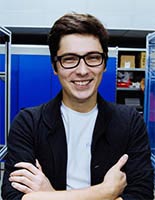Time-Variant Systems in Nonlinear Optics: From Frequency Conversion to Beating the Time-Bandwidth Limit
Hosted By: Nonlinear Optics Technical Group
24 September 2021 17:00 - 18:00
Eastern Time (US & Canada) (UTC -05:00)Time-variant systems constitute an exciting and rapidly developing field in photonics, advancing light-matter interactions and giving rise to topological and nonreciprocal devices. In this webinar hosted by the Nonlinear Optics Technical Group, Maxim Shcherbakov from the University of California, Irvine, will discuss the nonlinear-optical aspects of light interacting with materials (resonators and nanostructures) that are rapidly evolving in time.
The webinar will explore the possibilities of efficient frequency conversion in time-variant metasurfaces and ways to couple broadband optical pulses to narrowband resonators. Finally, the webinar will address the microscopic nature of time variance in solid-state materials, aiming to answer the question "Do time-variant systems belong to the realm of nonlinear optics?" from the quantum mechanical standpoint.
What You Will Learn:
- How light interacts with time-variant materials
- What physical mechanisms can be used to experimentally realize time-variant materials
- What is the microscopic nature of rapidly evolving materials
Who Should Attend:
- Undergraduate, graduate and postgraduate students, as well as optics professionals who are interested in learning more about time-variant systems in photonics
About the Presenter: Maxim Shcherbakov, University of California, Irvine
 Maxim Shcherbakov is an assistant professor with the Department of Electrical Engineering and Computer Science at the University of California, Irvine. He received his Ph.D. in Physics from Lomonosov Moscow State University, Russia, and in 2016 joined Cornell University as a postdoctoral associate. His main interests are artificial optical materials and their nonlinear and quantum optics applications, deep-subwavelength lithography, and augmented and mixed reality devices. He is an author of more than 50 research papers and book chapters and is a recipient of numerous photonics, telecommunications, and nanotechnology awards.
Maxim Shcherbakov is an assistant professor with the Department of Electrical Engineering and Computer Science at the University of California, Irvine. He received his Ph.D. in Physics from Lomonosov Moscow State University, Russia, and in 2016 joined Cornell University as a postdoctoral associate. His main interests are artificial optical materials and their nonlinear and quantum optics applications, deep-subwavelength lithography, and augmented and mixed reality devices. He is an author of more than 50 research papers and book chapters and is a recipient of numerous photonics, telecommunications, and nanotechnology awards.
